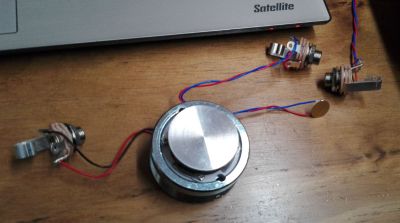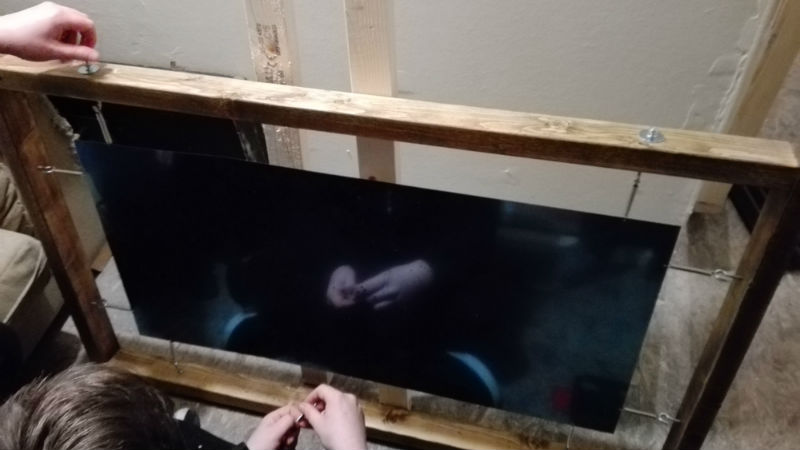For those who don’t spend their free time creating music with experimental audio effects, a plate reverb is essentially a speaker. It just happens to be, by design, a rather poor one. Rather than using a paper cone for a diaphragm like a traditional speaker, the plate reverb uses as you might guess, a metal plate. As the plate vibrates along with the source audio, a set of piezoelectric pickups convert that to an output. The end result is that audio fed into the plate reverb comes out with a nice echo effect.
 But despite their relative simplicity, a plate reverb costs thousands of dollars. They’re so expensive that the majority of people just emulate the effect in software. But it doesn’t have to be that way. [Sammartino] and an audio engineer friend recently came up with a detailed guide for building a plate reverb that cost about 10% of commercially available models.
But despite their relative simplicity, a plate reverb costs thousands of dollars. They’re so expensive that the majority of people just emulate the effect in software. But it doesn’t have to be that way. [Sammartino] and an audio engineer friend recently came up with a detailed guide for building a plate reverb that cost about 10% of commercially available models.
The construction is fairly simple. A wooden frame is built, and eight hooks are installed around the edges. The plate is suspended between these hooks using guitar strings, which holds it tight but with enough give to vibrate along with the tunes. Another board is attached across the center of the frame to support the electronics: a transducer to vibrate the plate, and two piezo pickups to convert that to an audio signal, and a couple jacks and some wiring to tie it all together.
For a different take on the DIY plate reverb, check out this one we covered all the way back in 2013. If you’re in the market for something a bit larger, we’ve got you covered there as well.
















I had the great good fortune to have worked at a facility that had a couple of the original EMT plate reverbs. These had quite substantial steel frames, and there was no use of coil springs or similar; the suspension clips were hi-tensile bolts with hooks going direct from holes on the plate edge to the steel frame. The required tension was high (I once read some joke instructions that said the right tension was to tighten til the clip breaks then back off a half-turn). This extreme tension is important to give the plate it’s “sheen” or brightness of the reverb sound. There was also a plate damper: a sheet of dense particleboard that could be moved towards or away from the steel plate to influence the overall decay time.
Given the quality of today’s software reverbs, it’s hard to imagine wanting to mess with plates again, except out of nostalgia…or hacking.
Really. That makes about as much sense as saying the spring reverb tank in my Fender amp is too much trouble. After all, it adds weight to the the cab, and has a valve that needs changing periodically. I mean sure, you have to tune a plate, but not often. Also some of the smaller models like the Ecoplate were not so very large. I honestly spend as much time fiddling with digital gear as I did with analogue. Aside from a few small conveniences I don’t see what all the fuss is about in terms of time saving.
Also I find the idea that plugins are even close quite laughable, I say this as I am surrounded by plugins and digital gear. Why bother going to all the effort of programming the perfect plugin when the real thing is a few pieces of steel, some tensioners and couple of piezos? Ok, and a transducer, and you have to build it. But so what? That’s all of $700 worth of things. I’ve spent more on guitar pedals. Seems like a bargain if you ask me.
Use one of these. https://www.parts-express.com/aurasound-ast-2b-4-pro-bass-shaker-tactile-transducer–299-028 Or one of the many things like these that have been sold over the years http://soliddrive.mseaudio.com/
All this effort, and no video?! I want to hear the thing cranked up!
Back in the sixties car reverbs had a short popularity. They used long springs. Was always entertaining when the cars went over a bump. Boing..oing…oing.
Who hasn’t accidentally kicked an amp with a spring reverb in it?
Over and over again, then processing it through a fuzz pedal, and adding a digital delay with regen cranked all the way up. Highly recommended.
Ah yes. Psychedelia… One could get away with a lot of things back then :)
Years ago I saw one of those come off the stack, hit the edge of the stage and land amongst the crew. It was their own fault, they hadn’t secured it properly. But it did make some really cool sounds until the leads pulled loose :)
I remember I saw one of this on a documentary. Always wanted to build one, for no reason at all, just for fun, probably use it once a year
If I didn’t get tortured so bad… I’d record some more signals to show how jack ass criminal ES/TS, or whatever the EW weapons, operators make anything act like a plate reverb.
i appreciate the synchronicity of running this article right after the bit on sophie germain, who contributed to the mathematical understanding of plate resonance
I have never heard a plate reverb that did not sound like a plate reverb. Traditional spring reverb units also have their own unique sound. Back in the analog days there was one reverb, a torsion spring reverb built by AKG. It was the BX-20 and it was the only reverb back in the day that really sounded natural. It also had s servo controlled damper so you could control the reverb time to some extent. Very cool piece of engineering from the “good old days”.
The BX-20 is an amazing unit, when you find one in good shape. However the reverb time is controlled electronically, not with a damper. You can see some shots of the spring mechanism on my website: https://analogaudiorepair.com/2013/05/03/akg-bx20-spring-reverb/
Ab anyone recommend a sheet metal supplier. The one linked in the article doesnt appear to supply sheet metal anymore.
Or please advise what type/grade and thinkness…..PLEASE. Thanks
I am planning to make plate reverb for my degree project. I am planning to use collect date comparing two different plates, one being steel and other I haven’t decided yet. Do you have any suggestion which another plate should I use for my project?
Copper, or tungsten, a “tank” of mercury, several different types of steel
In the DIY spirit, I once made a reverb out of a garage sale zither. I picked it up thinking it might make a cool addition to some tracks, but it would not tune, due to the wood being very old and the pegs wouldn’t turn without breaking the wood. So I glued the voice coil of a speaker to the back, in the middle. And then tacked a couple piezo mics to the front near the sound hole.
It sounded interesting, but it would probably have worked better with higher bandwidth pickup and excitation devices. I also had to hit it pretty hard using a 5 watt amp to get anything out of it. So it might have been better with a more robust amp.
That sounds awesome! It should have some of the strings vibrate sympathetically with whatever you’re driving it with. Could be an interesting effect b/c harmonically related. But I wouldn’t expect much reverb since the strings are so short, and you’re not exciting them along their length, but more probably through the bridge and longitudinally.
The excitation is where it’s always fallen down for me — I wonder if you couldn’t make something cool out of those surface-exciter speakers that Dayton makes. Some of them are aimed at real hi-fi.
Still, the sound you get out of an oven grill rack suspended from some strings has its own charm. There’s room for everything, no? (Take an oven rack, suspend it on two shoelaces. Wrap shoelaces around your fingers, and stick them in your ears. Gently tap on rack. Trust me on this…)